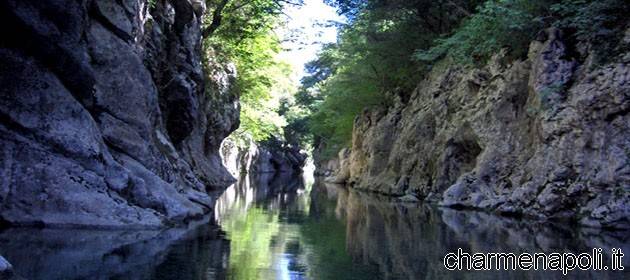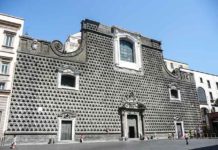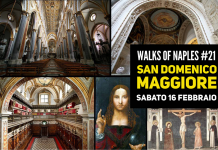If castles, vibrant towns, living forests, and millenniaspanning history are your thing, then Campania is the place for you. History lies thick on the ground in the region’s parks, managed and supervised by Luigi Nocera at the Regional Council’s Environment Agency, so here is a broad overview of the what is on offer.
Park of Taburno Camposauro.
Less than an hour’s drive from the bustling coast, the Park of Taburno Camposauro in the Apennines is an oasis of peace and quiet with the Prata plain between the limestone Mountains of Taburno and Camposauro. The 14 small towns and villages in the foothills each have their own special identity and there are splendid views from the two mountain tops which can be reached by following the paths made long ago by coal miners and lumberjacks. Now the ancient tracks are ideal for trekking with various degrees of difficulty amid a variety of are plants, shrubs and herbs. In the 4th century BC the area was controlled by the Samnite Federation in the Prata plain and here the invading Roman legions were humiliated at the Battle of Caudine Forks where they were disarmed and forced to march one by one under the yoke indicating their ignominious defeat. Visitors to the area today will appreciate the local produce, such as chestnuts, mushrooms, asparagus and herbs, as well as its craftsmanship, particularly wrought iron. Summer is the ideal time to visit the Park, with the Festival of Grain at Foglianise in August and important wine festivals at Torrecuso and Solopaca in September and October respectively, where fine wines from the area can be tasted along with typical local dishes. However the hillsides are beautiful all year round and tourists flock to towns like the medieval Sant’Agata dei Goti in early December for a special festival.
Park of the Picentini Mountains
In the heart o the Apennines between the upper reaches of the rivers Calore, Sabato and Sele in the provinces of Avellino and Salerno is the Regional Park of the Picentini Mountains. Covering 156,000 acres, the park has such peaks as Mount Cervialto (1809 m) which is bounded by Mount Accèllica (1660 m), Mount Terminio (1783), the Mai Mountains (1607m) and Mount Polveracchio (1790 m).
Park of the Lattari Mountains.
The mountain chain that separates the world-famous Sorrento and Amalfi coasts is part of the Park of the Lattari Mountains, home to deep valleys and beautiful coastlines with remains of Roman villas. Many peaks in the Lattari Mountains are above 1000 metres in height, such as Mount S. Angelo a Tre Pizzi (1440 m) and Mount Faito (1100 m) and the area is home to a number of rare, endemic plants such as Globularia napolitana. In summer the woodlands are alive with the birdsong of nightingales, cuckoos, thrushes and woodcocks, while owls come out to hunt at night.
Park of the River Sarno.
You cannot visit the Parks of Campania without seeing the archaeological sites of Pompeii, Stabiae and Oplontis, the necropolises in the Poggiomarino area, or the many other noteworthy buildings to be found in the Park of the River Sarno. Park of the Matese Massif. Craggy peaks and mountain pastures surround a beautiful lake at an altitude of 1100 metres in this regional park, which is home to some rare wildlife, such as royal eagles, kites, wolves and wildcats, while waterfowl can be found in the Mortine wetlands. There are also many castles, churches, shrines and museums in the area, which organises numerous cultural and religious festivals and fetes throughout the year, many of which date back to Roman traditions.
Park of the Partenio.
The Partenio trail is an important itinerary in the sphere of religious tourism. Key features include the medieval town of Mercogliano, the Shrine on Montevergine, as well as several other towns and churches, not to mention the park’s wildlife with 110 species of birds.
Park of Roccamonfina and the Mouth of the River Garigliano.
Local religious traditions are also a feature of the Park of Roccamonfina and the Mouth of the River Garigliano: the last Tuesday in May sees the traditional procession with the statue of Saint Anthony carried through the streets of Roccamonfina, while a similar ceremony accompanies the statue back to the Shrine in August. Carnival is a time of parties and parades and traditional food, such as Roccamonfina chestnuts, the symbol of a legend which claims that the founder of the shrine, the Franciscan friar Bernardino da Siena, asked God for a sign indicating where he should build the convent and, when he pushed his staff into the earth on this site, it put forth branches and leaves on this site. Another typical product is the melannurca campana apple, which is picked and left to ripen on beds of pine needles and wood shavings.
Camaldoli Town Park and Park of the Phlegraean Fields.
While the Camoldi town park preserves the large hillside area that was spared development in the 1960s and 1970s, the Phlegraean area north-west of Naples is a land of myth and legend where, according to Boccaccio, Venus was born. A Compulsory destination for young Europeans in the 19th century, the area is also bound up with the Miracle of Saint Gennaro, who was beheaded near the Solfatara on a stone whose red stain runs with blood every 19th September, as does the ampoule kept in Naples cathedral. Other festivals and celebrations are held throughout the year while April sees the Erculiadi, an outdoor sports and cultural event held in honour of Hercules. Other major sites include the Archaeological Park at Baia, the Roman Baths, the submerged Roman port, the castle, the Acropolis at Cuma, the amphitheatre of Pozzuoli, the Macellum, the Temple of Serapis and the Piscina Mirabile. Few places anywhere in the world can boast such a vast heritage of history, monuments and archaeology as that of the Phlegraean Fields.

 Italiano
Italiano














